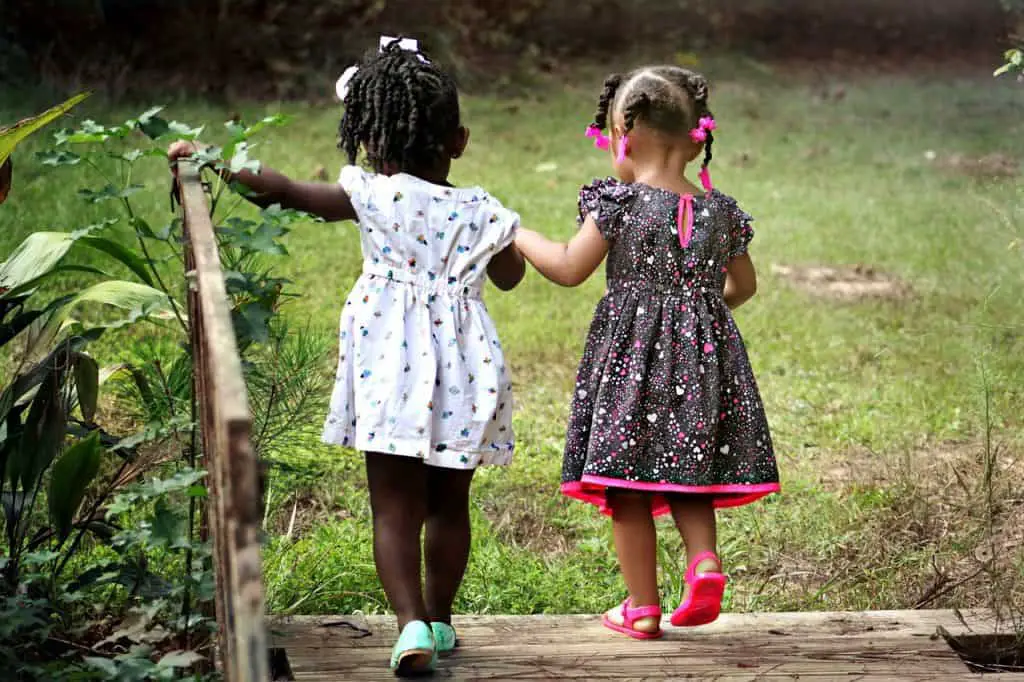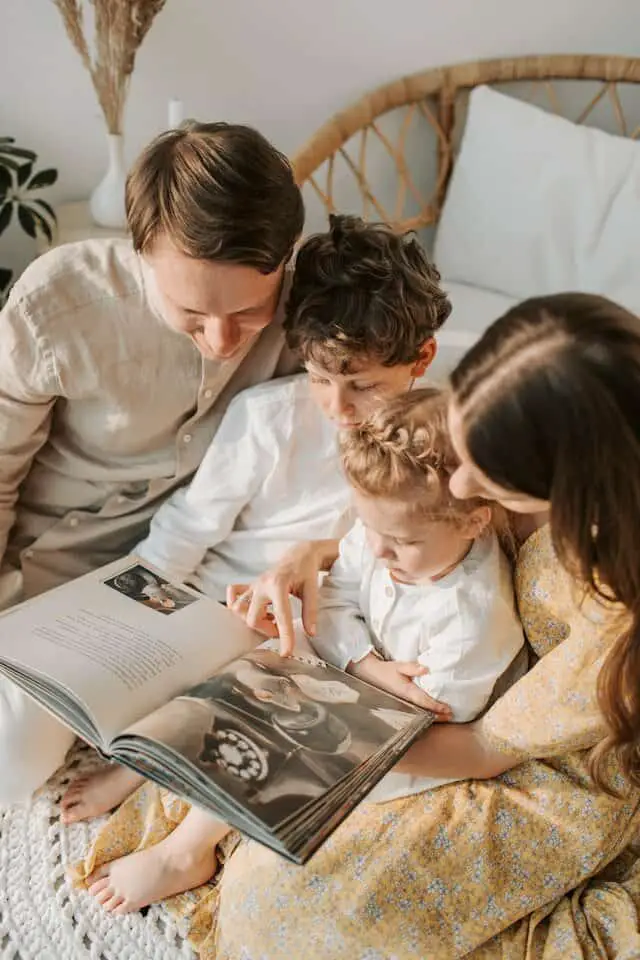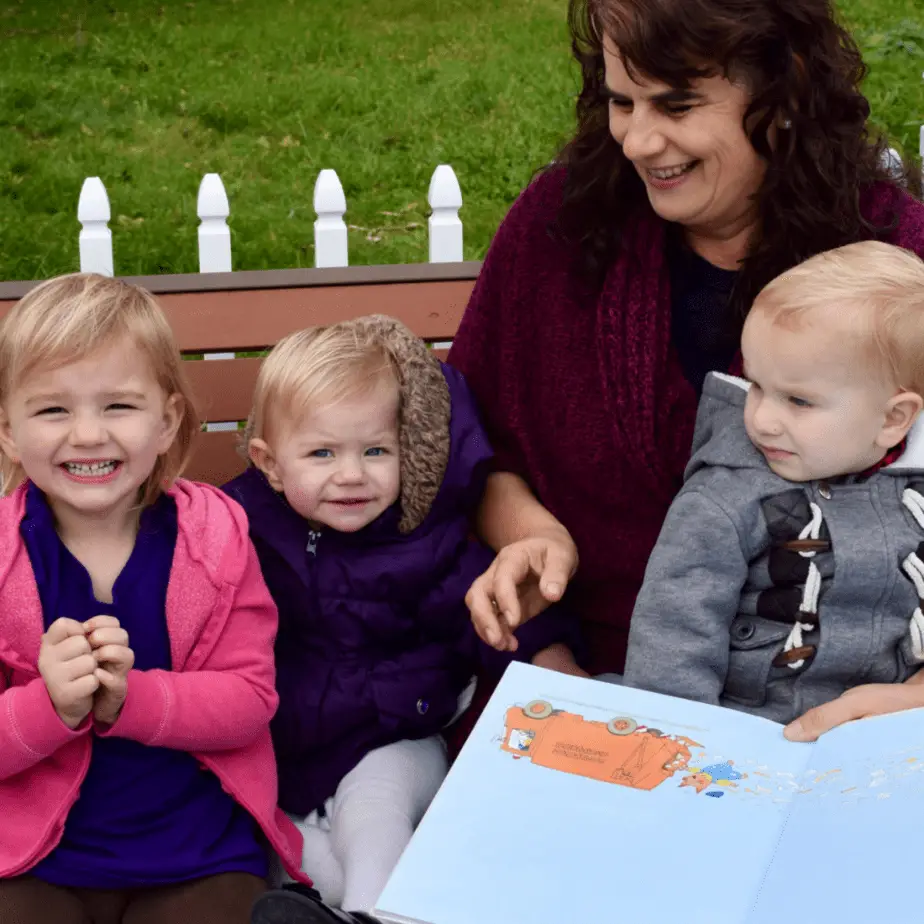
Helping kids develop empathy for others might be as simple as reading them stories.
I remember reading a story to my five year old son. It was about a little girl who gave away her favorite doll at Christmas time to a needy child. He was so moved by this act that he cried.
Seeing his tender heart touched me. I witnessed up close the power of story to teach empathy.
Empathy is about understanding the pain that someone else is feeling and joining them in their sorrow. It often leads to some action to help relieve the pain.
The amazing thing is that we can have real emotions triggered by fictional people. We can be moved to compassion and sympathy by hearing the plight of a fictional character.
Being able to crawl into the skin of another human is a critical life skill. Doing it with other people might be hard. Starting with a fictional character is easier.
The fact is, when we get lost in a story, we start to feel the characters emotions. We put our selves in their place. How would we feel if we were there in that situation? What would we be thinking? What would we do?
Research shows that parts of our brains are affected when we identify with fictional characters.
The pity and compassion we develop for a fictional character is real even if the character isn’t. It’s practice for having compassion for the real people in our lives. It helps us to reach out in love and sympathy and show others that we “weep with those who weep” and “rejoice with those who rejoice”.
Who can we feel empathy for? The list starts with the financially disadvantaged, physically disabled, racially different, culturally different and socially handicapped.
Some books teach these principles better than others.

Best Books for Teaching Empathy to Kids
In C.S. Lewis’ The Voyage of the Dawn Treader, Eustace Scrubb has a lot of problems. Chief among them is that he doesn’t read the right sort of books.
It’s an easy problem to fall into. But with a little forethought and research, we can surround ourselves and our kids with the right sort of books.
What are the right sort of books?
Literary fiction, to start with.
Julianne Chiaet writes in Scientific American about a study that compared the effects of reading non-fiction, popular fiction, literary fiction or no reading at all.
After reading, “the participants took a test that measured their ability to infer and understand other people’s thoughts and emotions.”
Those in the literary fiction group scored higher than the other three.
According to the article, literary fiction “focuses more on the psychology of characters and their relationships.”
Popular fiction tends to focus more on exciting plots and less on characters’ personal growth dealing with thoughts and feelings.
Besides the genre of literary fiction, certain themes are important as well as characters who are suffering or underprivileged in some way.
I previewed a stack of books that I found referenced on the internet as good resources to teach empathy. For the most part, I was underwhelmed.
A few stood out and I included them in my top picks.
The search reminded me about stories I heard as a child such as The Little Match Girl.
It’s written by Hans Christian Andersen, the same author who wrote The Ugly Duckling and The Emperor’s New Clothes.
Note: Pictures of book covers are Amazon affiliate links. Clicking through to purchase will benefit this site.

On a cold and snowy New Year’s Eve, a poor peddler girl is unable to sell any of her matches. She can’t return home because unsold inventory will result in a beating from her father. She has lost her shoes and her feet are red and blue with cold.
She huddles in a corner and strikes a match against the wall. She warms her hands in it’s glow and imagines roast goose and Christmas trees.
She strikes a bundle of matches and imagines her grandmother in heaven beckoning her to come.
Her body is found in the morning as the angels have carried her spirit away.
I admit it. It was heart breaking then. It’s heart breaking now. Are we afraid of broken hearts? Do we think that children can not handle the harsh realities of life?
Amazingly, this is a hopeful story. It paints the picture of heaven, of a better life to come.
But it is tragic as well, certainly. A little girl so cold that she froze to death, no celebration, no feast, no warmth, no mercy and kindness.
The vivid portrayal of the poor little match girl should stir our hearts, even though the little match girl is fictional. We don’t even know her name. What we know is her suffering.
Hans Christian Anderson, in just a few words, is able to portray the heavy weight of poverty, not just physical, material poverty, but the lack of kindness and compassion in a young child’s life.
Our sense of justice is offended by the unfairness of it all. No one should have to suffer the way the little match girl did.
Someone should have had pity on her.
Stirring up emotions for a fictional little girl is the beginning of empathy. It’s a short jump from feeling emotions towards a fictional character to feeling emotions for real people. They are actually the same emotions.
Maybe we shouldn’t be afraid of telling stories to kids that will produce a real emotional response.

5 Best Picture Books to Teach Empathy to Kids
1. Little Blue Truck by Alice Schertle

Little Blue Truck is a friendly sort, but he really shines when the big dump truck gets stuck in the mud and he rallies his friends to help him out.
2. Bear Feels Sick by Karma Wilson

Illness in a friend is a good time to flex those empathy muscles. Bear’s friends reach out to care for him when he’s sick.
3. We’re All Wonders by R. J. Palacio

Auggie has a significant facial deformity, but the message of this book is that we’re all more alike than we are different.
4. The Rabbit Listened by Cori Doerrfeld

Taylor’s huge creation made of blocks is destroyed, making Taylor sad. Different animals stop in, each with their own approach to help, but Taylor appreciates it most when Rabbit just listens.
5. Last Stop on Market Street by Matt de la Pena

CJ and his Grandma ride the bus home from church and he wonders why they don’t have a car, why he doesn’t have an iPod, why they get off in the dirty part of town. His grandmother helps him see the beauty and blessings of life.
6 Best Chapter Books to Teach Empathy to Kids
1. El Deafo by Cece Bell

A graphic novel that tells how Cece, a hearing impaired girl, deals with devices that help and relationships that are complicated by her disability.
2. The Hundred Dresses by Eleanor Estes

When Wanda is ridiculed by her classmates for wearing the same faded blue dress to school every day, she claims she has a hundred dresses at home. Her classmates learn too late the importance of kindness.
3. Wonder by R.J. Palacio

August Pullman was born with a facial deformity. Homeschooled till the fifth grade, Auggie is starting school for the first time. How can his mom, dad and sister help him navigate the social land mines of middle school?
4. The War that Saved My Life by Kimberly Brubaker Bradley

In London during World War II, children were sent to the country to flee the air raids. But for ten year old Ada, who has a twisted foot and a cruel mother, joining her brother to leave home is a chance at a new life.
5. A Single Shard by Linda Sue Park

Tree-ear is an orphan who becomes a potter’s apprentice in ancient Korea. He learns how to give and receive kindness.
6. A Place to Hang the Moon by Kate Albus

William, Edmund and Anna are recently orphaned siblings who are evacuated from London during the war. Their commitment to each other and longing for a real family drives this heart warming story.
*******************************
Since Hans Christian Andersen’s stories are now in the public domain, I’ve included the entire text of The Little Match Girl here. Find more of his stories online for free at Project Gutenberg.
THE LITTLE MATCH GIRL
Most terribly cold it was; it snowed, and was nearly quite dark, and evening—the last evening of the year. In this cold and darkness there went along the street a poor little girl, bareheaded, and with naked feet. When she left home she had slippers on, it is true; but what was the good of that? They were very large slippers, which her mother had hitherto worn; so large were they; and the poor little thing lost them as she scuffled away across the street, because of two carriages that rolled by dreadfully fast.
One slipper was nowhere to be found; the other had been laid hold of by an urchin, and off he ran with it; he thought it would do capitally for a cradle when he some day or other should have children himself. So the little maiden walked on with her tiny naked feet, that were quite red and blue from cold. She carried a quantity of matches in an old apron, and she held a bundle of them in her hand. Nobody had bought anything of her the whole livelong day; no one had given her a single farthing.
She crept along trembling with cold and hunger—a very picture of sorrow, the poor little thing!
The flakes of snow covered her long fair hair, which fell in beautiful curls around her neck; but of that, of course, she never once now thought. From all the windows the candles were gleaming, and it smelt so deliciously of roast goose, for you know it was New Year’s Eve; yes, of that she thought.
In a corner formed by two houses, of which one advanced more than the other, she seated herself down and cowered together. Her little feet she had drawn close up to her, but she grew colder and colder, and to go home she did not venture, for she had not sold any matches and could not bring a farthing of money: from her father she would certainly get blows, and at home it was cold too, for above her she had only the roof, through which the wind whistled, even though the largest cracks were stopped up with straw and rags.
Her little hands were almost numbed with cold. Oh! a match might afford her a world of comfort, if she only dared take a single one out of the bundle, draw it against the wall, and warm her fingers by it. She drew one out. “Rischt!” how it blazed, how it burnt! It was a warm, bright flame, like a candle, as she held her hands over it: it was a wonderful light. It seemed really to the little maiden as though she were sitting before a large iron stove, with burnished brass feet and a brass ornament at top. The fire burned with such blessed influence; it warmed so delightfully. The little girl had already stretched out her feet to warm them too; but—the small flame went out, the stove vanished: she had only the remains of the burnt-out match in her hand.
She rubbed another against the wall: it burned brightly, and where the light fell on the wall, there the wall became transparent like a veil, so that she could see into the room. On the table was spread a snow-white tablecloth; upon it was a splendid porcelain service, and the roast goose was steaming famously with its stuffing of apple and dried plums. And what was still more capital to behold was, the goose hopped down from the dish, reeled about on the floor with knife and fork in its breast, till it came up to the poor little girl; when—the match went out and nothing but the thick, cold, damp wall was left behind. She lighted another match. Now there she was sitting under the most magnificent Christmas tree: it was still larger, and more decorated than the one which she had seen through the glass door in the rich merchant’s house.
Thousands of lights were burning on the green branches, and gaily-colored pictures, such as she had seen in the shop-windows, looked down upon her. The little maiden stretched out her hands towards them when—the match went out. The lights of the Christmas tree rose higher and higher, she saw them now as stars in heaven; one fell down and formed a long trail of fire.
“Someone is just dead!” said the little girl; for her old grandmother, the only person who had loved her, and who was now no more, had told her, that when a star falls, a soul ascends to God.
She drew another match against the wall: it was again light, and in the lustre there stood the old grandmother, so bright and radiant, so mild, and with such an expression of love.
“Grandmother!” cried the little one. “Oh, take me with you! You go away when the match burns out; you vanish like the warm stove, like the delicious roast goose, and like the magnificent Christmas tree!” And she rubbed the whole bundle of matches quickly against the wall, for she wanted to be quite sure of keeping her grandmother near her. And the matches gave such a brilliant light that it was brighter than at noon-day: never formerly had the grandmother been so beautiful and so tall. She took the little maiden, on her arm, and both flew in brightness and in joy so high, so very high, and then above was neither cold, nor hunger, nor anxiety—they were with God.
But in the corner, at the cold hour of dawn, sat the poor girl, with rosy cheeks and with a smiling mouth, leaning against the wall—frozen to death on the last evening of the old year. Stiff and stark sat the child there with her matches, of which one bundle had been burnt. “She wanted to warm herself,” people said. No one had the slightest suspicion of what beautiful things she had seen; no one even dreamed of the splendor in which, with her grandmother she had entered on the joys of a new year.